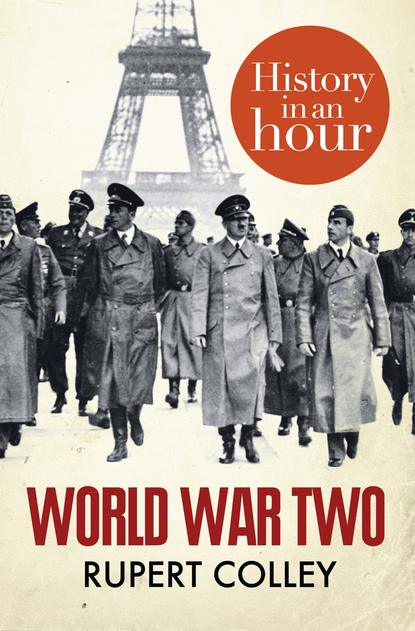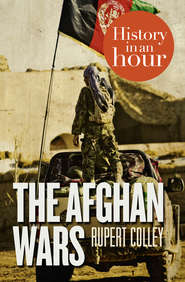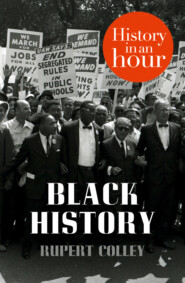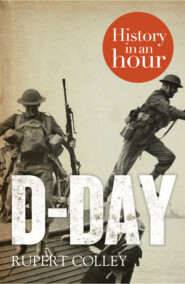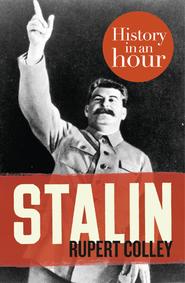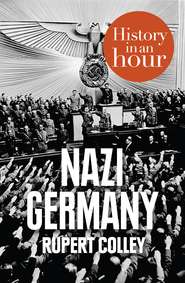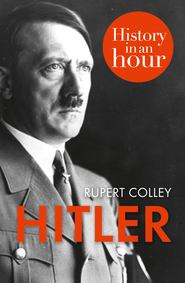По всем вопросам обращайтесь на: info@litportal.ru
(©) 2003-2024.
✖
World War Two: History in an Hour
Настройки чтения
Размер шрифта
Высота строк
Поля
World War Two: History in an Hour
Rupert Colley
Love history? Know your stuff with History in an Hour.Lasting six years and a day, the Second World War saw the lives of millions – soldiers and civilians, young and old – changed forever. During the conflict, a thousand people died for each and every hour it lasted. With eighty-one of the world’s nations involved and affected in some way, this was war on a truly global scale.Offering a wide overview of the major figures, politics and action on all sides, World War Two: History in an Hour provides a concise picture of the world upturned. How the conflicts began, the violence involved and how they affected a century: this is the story of the events that ended over sixty million lives and challenged our understanding of humanity.Love history? Know your stuff with History in an Hour…
WORLD WAR TWO
History in an Hour
Rupert Colley
About History in an Hour (#ulink_0b3f9bb4-0b80-50d7-9de7-5a53b6ff70b6)
History in an Hour is a series of ebooks to help the reader learn the basic facts of a given subject area. Everything you need to know is presented in a straightforward narrative and in chronological order. No embedded links to divert your attention, nor a daunting book of 600 pages with a 35-page introduction. Just straight in, to the point, sixty minutes, done. Then, having absorbed the basics, you may feel inspired to explore further.
Give yourself sixty minutes and see what you can learn ...
To find out more visit http://historyinanhour.com (http://historyinanhour.com) or follow us on twitter: http://twitter.com/historyinanhour (http://twitter.com/historyinanhour)
Contents
Cover (#ubf08056f-268f-5f29-b2f6-04223f4ca8a4)
Title Page (#u58ff049e-7608-5c27-a5dd-abba8fe7affb)
About History in an Hour
Introduction
Germany Invades Poland: ‘This is how I deal with any European city’
The Finnish–Soviet War: The ‘Winter War’
The Norwegian Campaign: ‘Missed the bus’
The Fall of France: ‘France has lost a battle but France has not lost the war’
The Battle of Britain and the Blitz: ‘It can only end in annihilation for one of us’
The Mediterranean: ‘One moment on a battlefield is worth a thousand years of peace’
North Africa: ‘A great general’
Germany’s Invasion of the Soviet Union: ‘The whole rotten structure will come crashing down’
War in the Far East: ‘Your boys are not going to be sent into any foreign wars’
The Battles of Stalingrad and Kursk: The new field marshal
The Holocaust: ‘The man with an iron heart’
The Battle of the Atlantic: ‘The U-boat peril’
The Big Three
Italy Falls: ‘You are the most hated man in Italy’
The Bomber Offensive: ‘My name is Meyer’
The Normandy Invasion: D-Day
France Free: ‘Liberated by her own people’
Approach from the East: ‘For the good have fallen’
The End of the War in Europe: The Death of a Corporal
The End of the War in Japan: ‘Complete and utter destruction’
Appendix 1: Key Players
Appendix 2: Timeline of World War Two
Copyright
Got Another Hour?
About the Publisher (#litres_trial_promo)
Introduction (#ulink_e7406e23-9721-510b-972e-39cc24b1b0aa)
Lasting six years and a day (until the formal surrender of Japan), the Second World War saw the civilian, both young and old, fighting on the front line. Civilian deaths accounted for 5 per cent of those killed during the First World War; but during the Second, of the 50 million-plus killed, they made up over 66 per cent. During the 2,194 days of the conflict, a thousand people died for each and every hour it lasted. With eighty-one of the world’s nations involved, compared to twenty-eight during the First World War, this was a world war in the truest sense.
Germany Invades Poland: ‘This is how I deal with any European city’ (#ulink_b5605bc7-6e09-5c00-ab97-f46aa174fd6e)
The Nazi-Soviet Non-Aggression Pact, signed on 23 August 1939, allowed Hitler to pursue his ambitions in the east without fear of Russian interference; ambitions that included the destruction of Poland and the subjugation of its people. The attack on Poland began at 4.45 on the morning of Friday, 1 September 1939.
Hitler inspects German troops invading Poland, September 1939
Bundesarchiv, Bild 183-S55480 / CC-BY-SA
The Germans, not intending to be bogged down again in a war of trenches and stalemate, swept aside all resistance in a lightning war of blitzkrieg, using technological military advances, co-ordinated attacks and abrasive speed. Following up the rapid advances, German forces engaged in brutality, executions and merciless aggression against the civilian population.
Neville Chamberlain, who had been Britain’s Conservative prime minister since 1937, and who five months earlier had guaranteed the Poles assistance if attacked, dutifully declared war on Germany on 3 September followed, six hours later, by the French. The British contribution to the Polish cause was not with arms, nor soldiers, nor aid, but with leaflets – by the million, dropped by plane over Germany, urging the population to stand up against Hitler and the war.
On 17 September, as the German war machine advanced its way towards Warsaw, the Soviet Union as secretly agreed in the Non-Aggression Pact, attacked from the east. Crushed between two totalitarian heavyweights, Poland crumbled, and on the twenty-seventh, Warsaw surrendered. Agreeing on the partition of Poland, the Germans and Russians then set about the total subjugation of the defeated population. Villages were razed, inhabitants massacred, the Polish identity eradicated; and in towns, such as Lodz, Jews were herded into ghettos before eventual transportation to the death camps. With his first objective achieved, Hitler visited Warsaw on 5 October, and casting a satisfied eye over the devastated capital, declared: ‘this is how I deal with any European city’.
The Finnish–Soviet War: The ‘Winter War’ (#ulink_490be690-c826-503e-ba24-66847018e9fd)
Stalin, knowing that his country’s pact with Germany would not last indefinitely, sought a buffer zone against any future German attack. By June 1940, he had bullied Estonia, Latvia and Lithuania into co-operation, swiftly followed by full annexation. Finland, however, resisted, preferring to fight than submit to Soviet demands. The 105-day ‘Winter War’ started with Russia’s attack on Finland on 30 November 1939. Russia, expecting an easy victory as the Germans had had over the Poles, was soon disabused, underestimating Finnish bravery, tenacity and expertize at guerrilla warfare.
Rupert Colley
Love history? Know your stuff with History in an Hour.Lasting six years and a day, the Second World War saw the lives of millions – soldiers and civilians, young and old – changed forever. During the conflict, a thousand people died for each and every hour it lasted. With eighty-one of the world’s nations involved and affected in some way, this was war on a truly global scale.Offering a wide overview of the major figures, politics and action on all sides, World War Two: History in an Hour provides a concise picture of the world upturned. How the conflicts began, the violence involved and how they affected a century: this is the story of the events that ended over sixty million lives and challenged our understanding of humanity.Love history? Know your stuff with History in an Hour…
WORLD WAR TWO
History in an Hour
Rupert Colley
About History in an Hour (#ulink_0b3f9bb4-0b80-50d7-9de7-5a53b6ff70b6)
History in an Hour is a series of ebooks to help the reader learn the basic facts of a given subject area. Everything you need to know is presented in a straightforward narrative and in chronological order. No embedded links to divert your attention, nor a daunting book of 600 pages with a 35-page introduction. Just straight in, to the point, sixty minutes, done. Then, having absorbed the basics, you may feel inspired to explore further.
Give yourself sixty minutes and see what you can learn ...
To find out more visit http://historyinanhour.com (http://historyinanhour.com) or follow us on twitter: http://twitter.com/historyinanhour (http://twitter.com/historyinanhour)
Contents
Cover (#ubf08056f-268f-5f29-b2f6-04223f4ca8a4)
Title Page (#u58ff049e-7608-5c27-a5dd-abba8fe7affb)
About History in an Hour
Introduction
Germany Invades Poland: ‘This is how I deal with any European city’
The Finnish–Soviet War: The ‘Winter War’
The Norwegian Campaign: ‘Missed the bus’
The Fall of France: ‘France has lost a battle but France has not lost the war’
The Battle of Britain and the Blitz: ‘It can only end in annihilation for one of us’
The Mediterranean: ‘One moment on a battlefield is worth a thousand years of peace’
North Africa: ‘A great general’
Germany’s Invasion of the Soviet Union: ‘The whole rotten structure will come crashing down’
War in the Far East: ‘Your boys are not going to be sent into any foreign wars’
The Battles of Stalingrad and Kursk: The new field marshal
The Holocaust: ‘The man with an iron heart’
The Battle of the Atlantic: ‘The U-boat peril’
The Big Three
Italy Falls: ‘You are the most hated man in Italy’
The Bomber Offensive: ‘My name is Meyer’
The Normandy Invasion: D-Day
France Free: ‘Liberated by her own people’
Approach from the East: ‘For the good have fallen’
The End of the War in Europe: The Death of a Corporal
The End of the War in Japan: ‘Complete and utter destruction’
Appendix 1: Key Players
Appendix 2: Timeline of World War Two
Copyright
Got Another Hour?
About the Publisher (#litres_trial_promo)
Introduction (#ulink_e7406e23-9721-510b-972e-39cc24b1b0aa)
Lasting six years and a day (until the formal surrender of Japan), the Second World War saw the civilian, both young and old, fighting on the front line. Civilian deaths accounted for 5 per cent of those killed during the First World War; but during the Second, of the 50 million-plus killed, they made up over 66 per cent. During the 2,194 days of the conflict, a thousand people died for each and every hour it lasted. With eighty-one of the world’s nations involved, compared to twenty-eight during the First World War, this was a world war in the truest sense.
Germany Invades Poland: ‘This is how I deal with any European city’ (#ulink_b5605bc7-6e09-5c00-ab97-f46aa174fd6e)
The Nazi-Soviet Non-Aggression Pact, signed on 23 August 1939, allowed Hitler to pursue his ambitions in the east without fear of Russian interference; ambitions that included the destruction of Poland and the subjugation of its people. The attack on Poland began at 4.45 on the morning of Friday, 1 September 1939.
Hitler inspects German troops invading Poland, September 1939
Bundesarchiv, Bild 183-S55480 / CC-BY-SA
The Germans, not intending to be bogged down again in a war of trenches and stalemate, swept aside all resistance in a lightning war of blitzkrieg, using technological military advances, co-ordinated attacks and abrasive speed. Following up the rapid advances, German forces engaged in brutality, executions and merciless aggression against the civilian population.
Neville Chamberlain, who had been Britain’s Conservative prime minister since 1937, and who five months earlier had guaranteed the Poles assistance if attacked, dutifully declared war on Germany on 3 September followed, six hours later, by the French. The British contribution to the Polish cause was not with arms, nor soldiers, nor aid, but with leaflets – by the million, dropped by plane over Germany, urging the population to stand up against Hitler and the war.
On 17 September, as the German war machine advanced its way towards Warsaw, the Soviet Union as secretly agreed in the Non-Aggression Pact, attacked from the east. Crushed between two totalitarian heavyweights, Poland crumbled, and on the twenty-seventh, Warsaw surrendered. Agreeing on the partition of Poland, the Germans and Russians then set about the total subjugation of the defeated population. Villages were razed, inhabitants massacred, the Polish identity eradicated; and in towns, such as Lodz, Jews were herded into ghettos before eventual transportation to the death camps. With his first objective achieved, Hitler visited Warsaw on 5 October, and casting a satisfied eye over the devastated capital, declared: ‘this is how I deal with any European city’.
The Finnish–Soviet War: The ‘Winter War’ (#ulink_490be690-c826-503e-ba24-66847018e9fd)
Stalin, knowing that his country’s pact with Germany would not last indefinitely, sought a buffer zone against any future German attack. By June 1940, he had bullied Estonia, Latvia and Lithuania into co-operation, swiftly followed by full annexation. Finland, however, resisted, preferring to fight than submit to Soviet demands. The 105-day ‘Winter War’ started with Russia’s attack on Finland on 30 November 1939. Russia, expecting an easy victory as the Germans had had over the Poles, was soon disabused, underestimating Finnish bravery, tenacity and expertize at guerrilla warfare.





